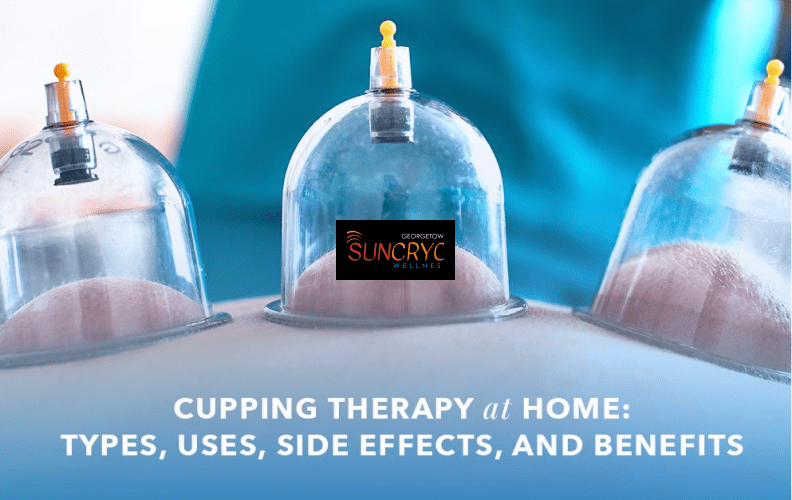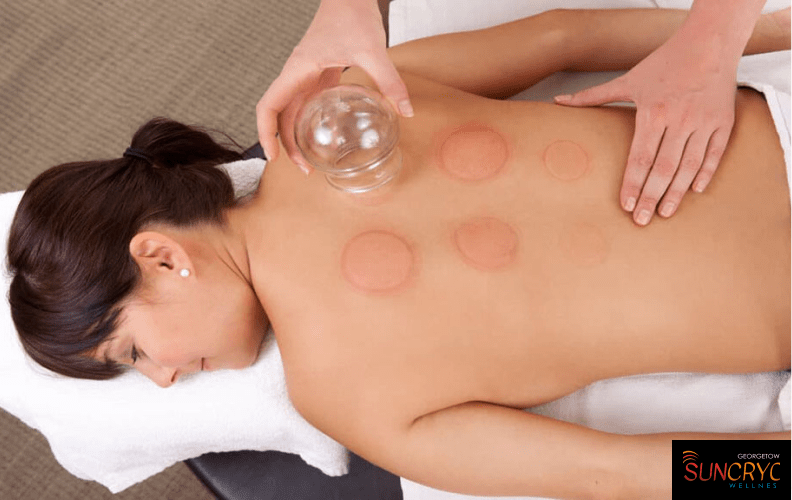Cupping Therapy

Cupping therapy, an ancient practice that originated in traditional Chinese medicine, has gained popularity in recent years for its potential health benefits. This therapy involves placing cups on the skin to create suction, which can help relieve muscle tension, improve blood flow, and promote relaxation. While it’s typically performed by trained professionals, you can also try cupping therapy at home with proper guidance. In this article, we will outline the steps to perform cupping therapy safely and effectively in the comfort of your own home. https://georgetownsuncryo.com/
What You Will Need
Before you begin, gather the necessary supplies
1. Cupping Set
You will need a cupping set, which can be easily purchased online or at a local health store. These sets typically include various-sized cups made from materials like glass, silicone, or plastic.
2. Massage Oil or Lotion
Choose a suitable massage oil or lotion to ensure the cups glide smoothly across your skin during the therapy session.
3. Cotton Balls and Alcohol
Have some cotton balls and rubbing alcohol on your hand to clean your skin and the cups before and after use.
4. Towels
Keep a few towels nearby to wipe away excess oil and for comfort during the therapy.
Steps to Perform Cupping Therapy

Now that you have your supplies ready, follow these steps to perform cupping therapy at home:
1. Prepare Your Space
Choose a quiet and comfortable place where you can relax. Lay down a towel to cover the surface where you’ll be sitting or lying. Ensure good lighting to help you see what you’re doing.
2. Cleanse Your Skin
Clean the area of your body where you intend to apply the cups with a cotton ball soaked in rubbing alcohol. This step is crucial to prevent infections.
3. Apply Oil
Apply a thin layer of massage oil or lotion to the skin. This allows the cups to glide smoothly and prevents excessive friction.
4. Create Suction
Select a cup size appropriate for the area you want to treat. Squeeze the cup’s top to create a vacuum and place it in the desired location on your skin. Release the pressure gently to create suction. You should feel your skin being drawn into the cup.
5. Leave the Cups in Place
Let the cups remain in place for about 5 to 10 minutes. You may feel a slight pulling sensation, which is normal. If the suction becomes uncomfortable or painful, remove the cup immediately.
6. Move the Cups
If you want to target different areas, repeat the process by moving the cups to the next location. Always reapply oil to maintain smooth gliding.
7. Remove the Cups
To remove the cups, gently press on the skin near the cup’s edge to release the suction. Never pull the cups off abruptly, as this can cause skin bruising.
8. Massage the Area
After removing the cups, use your hands or a massage tool to gently rub the treated area. This helps to further release tension and improve blood flow.
9. Clean the Cups
Clean the cups with rubbing alcohol and cotton balls to ensure they are free from oil and bacteria before storing them.
10. Rest and Hydrate
After your cupping therapy session, take some time to rest and hydrate. Cupping may leave temporary marks on your skin, which should fade within a few days. https://georgetownsuncryo.com/
Precautions and Tips
- Consult with a healthcare professional if you have any underlying medical conditions or concerns before attempting cupping therapy at home.
- Do not use cupping therapy on broken or irritated skin, or over areas with varicose veins, moles, or recent scars.
- Start with shorter sessions and gradually increase the duration as your body gets accustomed to cupping.
- Be cautious and gentle, especially if you are new to cupping, to avoid excessive bruising or discomfort.
Conclusion
Performing cupping therapy at home can be a relaxing and potentially beneficial experience when done correctly. By following the steps outlined in this guide and taking the necessary precautions, you can enjoy the soothing effects of cupping therapy in the comfort of your own home. However, always remember to consult with a healthcare professional if you have any doubts or concerns about this practice. https://www.stridephysiotherapy
